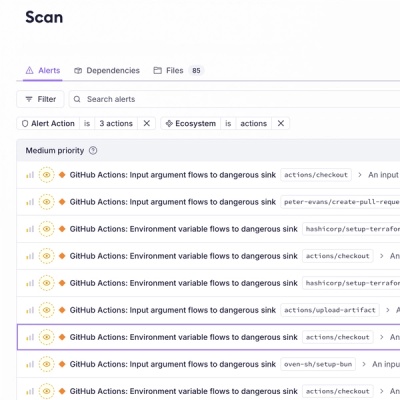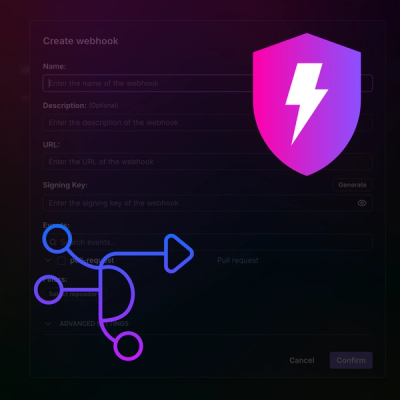
Security News
New CNAPulse Dashboard Tracks CNA Activity and Disclosure Trends
Open source dashboard CNAPulse tracks CVE Numbering Authorities’ publishing activity, highlighting trends and transparency across the CVE ecosystem.
@tru_id/dev-server
Advanced tools
An example tru.ID server to help with the tru.ID development process
The tru.ID development server provides basic example code to be used with client application, runnable examples via served web pages and can be used to help with the tru.ID development process.
The server can be used from standalone from source or installed and used as a module.
You will need:
Clone or unzip the tru.ID Node Server into a directory.
$ tru login {IDP}. Replacing {IDP} with your Identity Provider (google|github|microsoft).$ tru projects:create --project-dir PATH_TO_SERVER_DIR. This will create a tru.json file in the directory.npm install
# or
yarn install
If required, you can make configuration changes with the following environment variables:
PORT : change the port that the server listens on.DEBUG : determines whether debug information is logged via console.log.CONFIG_PATH : the path to the tru.json configuration file for the tru.ID project. Not used if TRU_CLIENT_ID and TRU_CLIENT_SECRET are set.API_BASE_URL : the tru.ID base URL. Defaults to https://eu.api.tru.id (https://in.api.tru.id is also available)TRU_CLIENT_ID : The client_id of a tru.ID project.TRU_CLIENT_SECRET : The client_secret of a tru.ID project.USERNAME : A username to be used with basic auth for the site.PASSWORD : A password to be used with basic auth for the site.NGROK_SUBDOMAIN : If you have ngrok premium membership, you can define your ngrok subdomain here.NGROK_AUTHTOKEN : Your ngrok auth token found in the ngrok dashboardNGROK_REGION : The region the ngrok tunnel is set up in.The server will attempt to load environment variables from a .env file in the root directory of the server.
The final step to a successful Phone Check for v0.2 is to provide a redirect_url back to your server. With this dev-server, you must:
{local_tunnel_url}/v0.2/phone-check/exchange-code (replace {local_tunnel_url} with the URL exposing your localhost server to the Internet).If you wish to receive Phone Check HTTP callbacks when the Phone Check enters and end state, you must:
phonecheck_callback_urlFrom the project directory run the following command replacing {local_tunnel_url} with the URL exposing your localhost server to the Internet:
$ tru projects:update --phonecheck-callback {local_tunnel_url}/phone-check/callback
There are two ways you can run this dev-server for testing with, the first one is to be run locally, needing a service such as Ngrok to expose the server to the Internet. The second method is to deploy it to a sevice such as Fly.io.
npm start
# or
yarn start
Fly.io is a Platform-as-a-Service (PaaS) allowing developers to deploy full stack applications with minimal effort.
To deploy the dev-server remotely, install the Flyctl CLI. This CLI provides functionality for signing up, logging in, and deploying.
Two environment variables are required TRU_ID_CLIENT_ID and TRU_ID_CLIENT_SECRET, which can be found in your tru.json file. These are needed to verify the checks. So run the command below to register these in your Fly.io project:
flyctl secrets set TRU_ID_CLIENT_ID=<YOUR_CLIENT_ID> TRU_ID_CLIENT_SECRET=<YOUR_CLIENT_SECRET>
Note: Please keep in mind that deploying this remotely could result in the API endpoints being publically accessible to anyone unless you secure these endpoints with authentication, the server will also be running until you close it down.
Running flyctl launch will prompt you for some pieces of information about your application, including the region you wish this to be deployed to. If you're using the tru.ID's India Data Residency, you may want to choose the Chennai (Madras), India for your deployment.
At the end of this, you'll also be asked if you wish to deploy this application remotely. Choose yes.
flyctl launch
Your backend server is now ready to be used on the URL: https://<fly.io project name>.fly.dev.
We keep a separate branch deploy_fly_io that contains the necessary changes for our internal deployment. Make sure to merge any changes from main to deploy_fly_io and then when you are ready to deploy run
flyctl deploy
npm install @tru_id/dev-server
# or
yarn add @tru_id/dev-server
const truDevServer = require('@tru_id/dev-server')
truDevServer.serve(config)
{
// Number. The port for the server to listen on. Defaults to 8080
port: PORT,
// Boolean. Whether debug output will be passed to the `log` function. Defaults to `true`
DEBUG: DEBUG,
// String. The base tru.ID URL. Defaults to 'https://eu.api.tru.id'
apiBaseUrl: API_BASE_URL,
// Optional. Set if the server should be password protected. Uses [express-password-protect](https://github.com/jdmann/express-password-protect)
basicAuth: {
username: USERNAME,
password: PASSWORD
},
// Object. The tru.ID project configuration to use.
project: {
// String. The `client_id` of the project. Defaults to loading from a local `tru.json`.
client_id: CLIENT_ID,
// String. The `client_secret` of the project. Defaults to loading from a local `tru.json`.
client_secret: CLIENT_SECRET
},
// Object. Configuration for [ngrok.com](https://ngrok.com/)
ngrok: {
// Boolean. Whether ngrok should be run to expose the running server to the public Internet. Defaults to false.
enabled: NGROK_ENABLED,
// String. A subdomain to use with ngrok. No default. Note: unless you have a premium membership you cannot get a defined subdomain.
subdomain: NGROK_SUBDOMAIN,
// String. Your ngrok auth token found in the [ngrok dashboard](https://dashboard.ngrok.com/get-started/setup).
authtoken: NGROK_AUTHTOKEN,
// String. Choice of location where the ngrok client will connect to host its tunnels.
region: NGROK_REGION
},
// Function. A function called with debug information when `DEBUG` is set to `true`. See below for default.
log: (...args) => {
if(DEBUG) {
console.debug(...args)
}
}
}
Ensure the CHANGELOG.md is updated and update the package version:
yarn run changelog
Finesse the contents of CHANGELOG.md and commit with a message:
chore(release): v{version}
Tag the version that is being released with the version of the package and, optionally, the tag to be used in NPM:
git tag v{version}@{tag}
Push the update to the remote.
git push origin v{version}@{tag}
To release a canary version run:
yarn run publish:canary
To release a latest version:
yarn run publish:latest
FAQs
An example tru.ID server to help with the tru.ID development process
We found that @tru_id/dev-server demonstrated a not healthy version release cadence and project activity because the last version was released a year ago. It has 4 open source maintainers collaborating on the project.
Did you know?

Socket for GitHub automatically highlights issues in each pull request and monitors the health of all your open source dependencies. Discover the contents of your packages and block harmful activity before you install or update your dependencies.

Security News
Open source dashboard CNAPulse tracks CVE Numbering Authorities’ publishing activity, highlighting trends and transparency across the CVE ecosystem.

Product
Detect malware, unsafe data flows, and license issues in GitHub Actions with Socket’s new workflow scanning support.

Product
Add real-time Socket webhook events to your workflows to automatically receive pull request scan results and security alerts in real time.